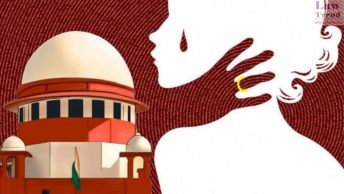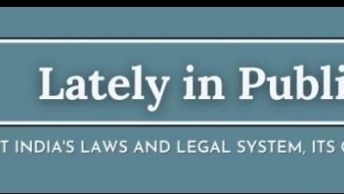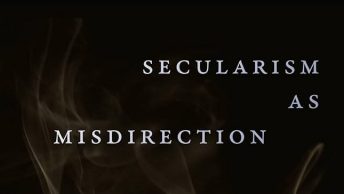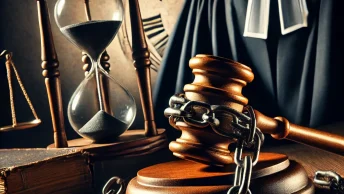Mr. Venkatesan in his rejoinder to my comments makes a strong attack on the Supreme Court stay order. I am sufficiently provoked by his incisive comments to posting this response. In his comments, Mr. Venkatesan has raised issues which go beyond his previous post. Given the nature of his comments, I thought the best way to do justice was to give my detailed justification for the SC order on OBC quota. Apologies if this response was long
Our Constitution commands the creation of an egalitarian society where everyone gets the freedom of opportunity for social and economic advancement. To that extent quotas may be a useful instrument for achieving that objective, provided they are structured in the right way and targeted to the right audience. The executive should certainly have flexibility in designing these programs, but not to the exclusion of an independent judicial review, which is necessary to ensure that these programs are targeted to the right audience. I also believe that the Constitution commands the creation of a casteless society. I understand that caste is a social reality that cannot be wished away easily, but reinforcing it through caste centric quotas—without any investigation into a caste-neutral mechanisms which can reach the same audience—is certainly not the right path for the creation of a casteless society. My biggest concern with caste centric programs is that it facilitates identity politics. It enables the political leadership to use caste as proxy for performance. It creates a vested interested in continuing the caste system. The best example is probably UP where you “don’t caste your vote, but vote your caste.” The political class is not going to stop these programs because they have built a constituency around it. The Supreme Court in Indra Sawhney had a rare opportunity to stop this program, but unfortunately the Court ended up blessing these programs.
The key point which I intend to make through this post is that the government is bound by the entire ruling in Indra Sawhney. It cannot accept those parts which favor it and discard the inconvenient parts.
Requirement of objective material.
Mr. Venkatesan in his rejoinder undermines the requirement of providing data to support quotas. He asserts that “surveys conducted on a large scale are not the answer to determine whether a caste is SEBC. The answer has to be found in anthropology and sociology, not in statistics.” In his opinion, “if the modern-day governments instinctively, and by way of impulse and formal and informal studies consider a caste as backward, such consideration can be largely respected”
I find it difficult to share his opinion given unambiguous language in Indra Sawhney. His assertion belies the compromise formula evolved by the Supreme Court in Indra Sawhney in 1992. Some background explanation is in order to explain this point.
In Indra Sawhney, the legal legend Nani Palkhivala rightly contended that caste is a constitutionally prohibited criterion in Article 15(2), Article 16 and Article 18 and it cannot become a permissible criterion when it comes to identification of “backward class”. On the other hand, Union of India contended that caste has to be the dominant consideration. Three judges accepted Mr. Palkhivala’s contention (Justice Thommen, Kuldip Singh and R.M. Sahai). Justice Pandian rejected it. Justice Jeevan Reddy, speaking for four judges, stuck the middle ground. He did accept the government’s contention that caste being a social reality can be used to identify backward classes, but he hedged it with the following qualifications and it is these qualifications which acquire importance in this case. These qualifications are: (The paragraph nos are from 1992 Supp (3) SCC 217
a. The authorities can adopt any reasonable method to identify backward class. It can begin with caste, but it cannot be solely based on caste.
b. While identifying backward class, it must be done with reference to the entire population of the state. Para 796-797—(“any method so long as it covers the entire populace. …The central idea is that it should cover all groups, classes in society.”) See Para 782—(“ultimate idea is to survey the entire populace”); Para 782—(“effort should be to consider all available groups and classes, in whichever order one proceeds”);
c. An assessment of “backwardness” has to be made in comparison with the rest of the population of the state. Para 795—(“backwardness being a relative term must be judged by the general level of advancement of the entire population of the state.”)
d. A periodic revision has to be held.
e. Any approach used to identify backward classes has to be “fair and adequate” (Para 783)
f. Any determination of backwardness has to be based on objective social criterion. (Para 737) (“Any determination of backwardness is not a subjective exercise nor a matter of subjective satisfaction. … the exercise is an objective one. Certain objective social and other criteria has to be satisfied before any group or class of citizens could be treated as backward.”)
g. Creamy layer has to be excluded (Although this observation was made in the context of 16(4), it was subsequently extended by the Supreme Court judgments to Article 15(4) also)
h. Judicial review is always available to ensure that the assessment of backwardness is done in an objective manner.
This is a carefully hedged formula which was evolved in Indra Sawhney. If the govt want to use caste as a basis for identifying “socially and educationally backward class”, it also has to implement these processes which have been designed to identify backward class. Mr. Venkatesan cites the first instance of reservation in 1902 and 1921 where the “princely states did not go about collecting data, but responded immediately to the demands, in order to prevent social unrest” But between 1921 and 2007, we had a Constitution which does not contemplate quota on the basis of social unrest, but rather on an objective determination of backwardness.
What kind of data is required to show that OBC are “socially and educationally backward”?
Mr. Venkatesan poses a question to me as to what kind of data is required to show that a particular caste constitutes a backward class. He says “large scale surveys” are “naïve” and they would not lead to “fool-proof results”. Neither a large scale survey nor a fool-proof material is required.
The Supreme Court in Indra Sawhney has given the broad methodology for identifying backward classes. Under this method,
1. The government has to lay down the criterion for identifying backwardness. These criterion have to be fair and adequate.
2. Based on the criterion, the government has to conduct a survey of the population.
3. The government then has to make an assessment as to whether a particular caste/community is backward compared with the rest of the population.
4. This survey has to be held once in 10 years by an independent backward classes commission.
Does the survey need to go and each and every village? Not necessary. As long as the government identifies fair and adequate criterion and uses a reasonable sample, the court will not interfere. Does the sample needs to be perfect? Again not required.
In Indra Sawhney, Justice Jeevan Reddy laid down the “best efforts” test – the commission has to use its best efforts in identifying backward classes. It need not collect all the particular materials and reservations. (“In spite of best efforts that any commission may make in collecting materials and datas, its conclusions cannot be always scientifically accurate in such matters. Therefore, the proper approach, in our opinion should be to see whether the relevant data and materials referred to in the report of the Commission justify its conclusions.”) (relying on State of AP v. Balram, AIR 1972 SC 1375)
Isn’ t this elaborate process time consuming and detrimental to the interests of backward class?
Yes. It is time consuming and that’s why it is supposed to be done once in ten years. This process is required because “backwardness” suggests a relative state of affairs. A community can be identified as “backward” only in comparison to the state of the general population. Identifying the deserving “backward classes” is important because it ensures that quota benefits reaches the correct audience. The government just cannot “instinctively and by way of impulse” identify backward classes. Such unrestricted freedom could lead to perverse results and goes against the approach laid down in Indra Sawhney
Should not the same methodology be followed for SC and ST?
First, as I pointed out earlier, “backwardness” is a relative state of affairs. A community is backward only with reference to the entire population and that’s the reason for a periodic survey of the population and objective material before a community or caste can be assessed as backward. But SC/ST are a fixed class of communities. Their composition does not change based on the rest of the society. Even if a society advances they will be still be entitled to quota. But backward classes are entitled to affirmative action as long as they are backward, but once they move out of that category, they are no longer entitled to reservation. Only on the basis of a survey, one can determine who should be included and excluded among backward classes. This is never done for SC/ST. The only exception where a survey of SC/ST population is required is for the purpose of Article 16(4) which requires an “adequate representation” in proportion to the population. The objective of that survey is not an enquiry into the status of SC and ST, but rather an inquiry into their population.
Does the Govt have enough material to show that OBC’s are backward?
Now comes the crucial question – did the government have “objective material” before introducing the 27% for OBC quota? Does the state have any material which shows whether the various OBC qualifies as a backward class? According to Mr. Venkatesan the government does have material. He relies on the Mandal list and the state lists of backward classes which forms the basis for the central list of backward classes. Let me deal with each of them
a. The Mandal list: The Mandal Comission list which was submitted in 1980 and was based on the data from the 1961 census (even though 1971 census was available).
b. Most of the state lists have not been revised for decades. In AP the last time a survey of backward classes was done was in the year 1972. Most states have not revised their lists for almost three or four decades. Karnataka has recently initiated a comprehensive exercise of identifying backward classes.
c. While most states have appointed backward class commissions, their recommendations are based on surveys conducted three decades ago. They have not undertaken any fresh surveys.
d. Not are these state lists old, most states also do not maintain separate lists of backward classes for the purpose of Article 16(4) and Article 15(4)
The central list of backward classes is thus vitiated because it is based on state lists which are themselves obsolete. One cannot provide quota for backward classes in 2007 which have been identified way back in the 1970’s.
Mr. Venkatesan places strong reliance on the National Commission of Backward Classes (NCBC) to show that this Act has appropriate mechanism to deal with the concerns on these state lists. I differ for the following reasons
First, section 11 of the NCBC Act, based on the Indra Sawhney judgment, imposes an obligation on the Central government to conduct a revision every 10 years in consultation with the NCBC. As per Indra Sawhney, the government has to conduct a survey. Chapter VI of the Annual Report of the Commission for 2003-04 (this is the latest report available online on the NCBC site) clearly admits that a revision requiring survey has not been done and requests the central government to provide assistance and infrastructure for this purpose. The NCBC felt constrained to reiterate its recommendations of earlier years in its Annual Report. Let me quote the commission itself – “There is also the important task arising out of Section 11 of the National Commission for Backward Classes Act, viz. the revision of the Central lists, which is a massive exercise. In carrying out such tasks, the Government and the Commission will feel utterly handicapped in the absence of generation of relevant data/information regarding castes/communities. … This is essential particularly for the purpose of the revision of the Central Lists envisaged under Section 11 of the National Commission for Backward Classes Act. So far none of the States have been able to furnish to this Commission, adequate and useful data in respect of castes/communities contained in the respective Central Lists for these States.” Clearly the NCBC itself admits that the states have not provided any data and they are still tinkering with the three decades old state lists. A revision without a survey would not only amount to a violation of Indra Sawhney, but also a violation of Section 11 of the NCBC Act
Second, Mr. Venkatesan strongly relies on power of the Commission to examine complaints of over inclusion and under inclusion (Section 9 of the NCBC Act). He faults the petitioners for not relying on this mechanism. I strongly differ. It will be futile to rely on such a mechanism. Over inclusion/under inclusion complaints can only be judged against the backdrop of a proper framework which has been devised after conducting a survey based on “fair and adequate” criterion. In case of OBC, since the framework itself goes back to the early seventies for many states, the only way you can judge a complaint is by going back to the criterion by which those lists have been devised. This in turn perpetuates the mistakes committed in identifying backward classes.
Clearly the OBC quota as it stands now is based on highly questionable data. The judiciary is certainly entitled to ask the government for objective material support its policy.
Another advantage of doing a survey of the population is that it brings out the proportionality element. Backwardness is not a fixed concept and there are varying levels of backwardness. Quota is the extreme step which may not be justified if the backwardness can be redressed by a preference in terms of extra marks or any other such mechanism.
The real reason why most states are not inclined to do a survey is because of a fear that certain communities might have to be excluded and some of them are politically powerful (The Vokkaliga community which is an OBC in Karnataka has been often cited as an instance)
In my personal opinion, I would rather prefer a deprivation index (borrowing from the work of several sociologists) in which caste is “a” factor and not “the” factor in identifying backward classes. Social and educational backwardness can be a product of poverty, education, social milieu, parents profile and place of birth and therefore all of them have to be taken into account. Giving quota to a OBC candidate who was born to well educated parents, attends an English medium private school and grows up in an urban milieu over a non-OBC candidate who is born in a rural village, goes to a govt school, born to illiterate or semi-educated parents is to my understanding a clear violation of Article 15 (1) which prohibits discrimination on the basis of caste and there is nothing in the Constitution – not even Article 15(4) – that justifies such a result. This scenario is not an exception, but a social reality. (The only way one can say it is an exception is on the basis of recent objective material which the government does not have!)
Was the Court justified in giving the stay?
I don’t have any strong views on this aspect. Although a stay on a legislation should not be granted as a matter of course, it is certainly not unprecedented. I do think the Court was justified in staying the statute. Mr. Venkatesan relies on presumption of constitutionality and balance of convenience.
First, the presumption of constitutionality is a well settled constitutional law principle. But it is still a presumption and like all other presumption, its sole purpose is to shift the burden of proof. In Constitutional law, this presumption operates to impose a burden on the petitioner to show the statute is unconstitutional. The petitioner has to begin by showing that the statute is unconstitutional. Once the petitioner does that, the burden shifts to the government to defend the statute. In this case, the petitioner has asserted that OBC quota violates Article 14 and in particular Article 15(1) and it is not protected by Article 15(4) and 15(5) since the material on record does not support quota for OBC. But Mr. Venkatesan wants the petitioner to prove the absence of data. I doubt the Court has ever asked a petitioner in a constitutional litigation to prove a negative. In constitutional and administrative cases, once the petitioner alleges lack of material, it is the government’s job to show that it based its decision on objective material since that information is within the exclusive possession of the government. In this case, the petitioners showed that the existing material did not support the OBC quota decision, and the judge found that the government failed to show any objective material which backs the decision of the government to have 27% quota. So he gave more time for the government to submit material to back up their decision. It is in this context, I made the assertion in my previous comment that what the court is really saying is that the law is unconstitutional as of today but can become constitutional if the government presents sufficient data. The judge held a mini-hearing for the purpose of granting a stay order. And once he did that, he is perfectly entitled to grant a stay order.
Mr. Venkatesan relies on the R.K. Garg case. If I am not mistaken that case was in the context of a VDIS scheme which falls within the realm of economic policy. The Supreme Court has always professed a strong doctrinal indifference to reviewing economic decisions which involve policy. But the situation completely changes when it comes to caste centric reservation since it is based on the constitutionally prohibited criterion of caste. Some of the Indian judgments have used the American terminology of “strict scrutiny” when a constitutionally suspect classification of caste or religion is invoked. An economic legislation does not attract that level of scrutiny.
Second, the concept of balance of convenience is a concept which is borrowed from civil procedure. It is invoked when the Court does not have the time to hear the parties on the merits of the case, but has to award interim relief. When the case first came up before this Court, the balance of convenience was in the favor of the government, but once the court heard the parties and examined the written submissions, the concept of balance of convenience is no longer relevant.







Dear Vivek,
Welcome aboard, and thanks for your post, which as inaugural posts go, may well be the most substantive (and stimulating) one we’ve had so far. Thanks for pointing out the relevant parts of the Indra Sawhney case, so that the rest of us can read up on this issue.
I’m sure Mr. Venkatesan will have a response coming up soon, but I am guessing he, more than the rest of us, appreciates the value you bring to this enterprise. Looking forward to many more posts,
Arun
I have written on reservation issue in my blog in Tamil.
http://ravisrinivas.blogspot.com
See also my response on creamy layer question in EPW Demystifying the Anti-Creamy Layer – Economic & Political Weekly Vol XLII No 4
Jan27-Feb 2, 2007, Pp327-328